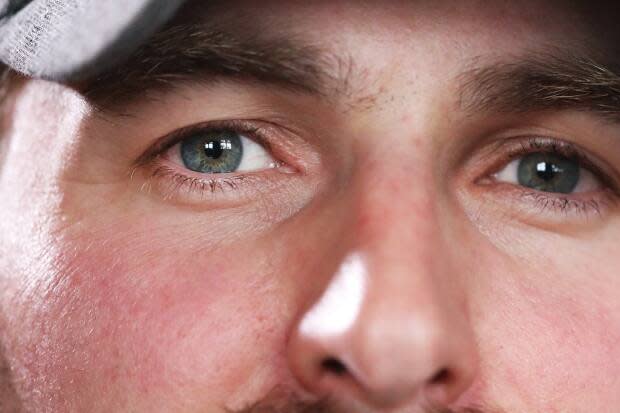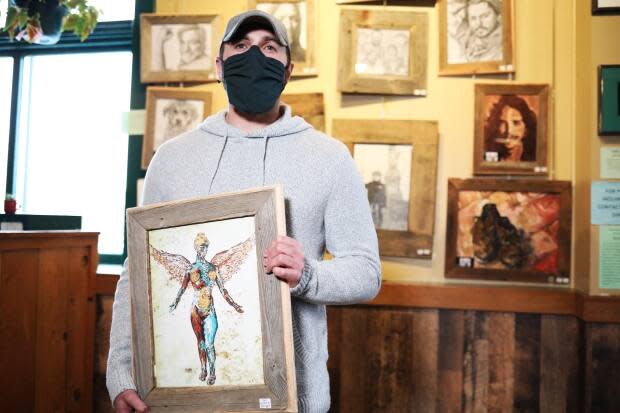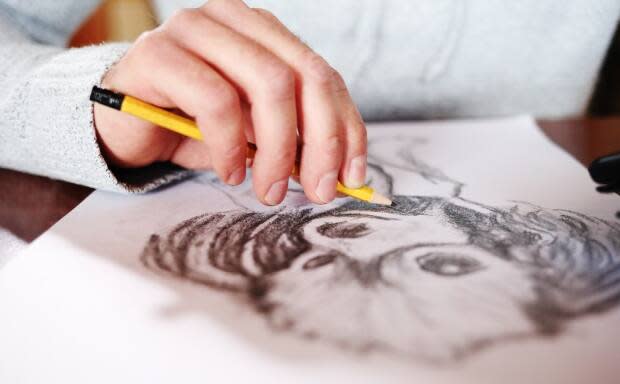Sask. artist doesn't let visual impairment get in the way of his drawing

As Dustin Ritter picks up his pencil and starts to draw, he immediately breaks into a smile. The portrait artist may not see perfectly, but his pencil lines are clear and purposeful.
"I think people are really surprised that I can draw because of my condition and, again, I have to explain how it works for me," he said. "I do have what people call an invisible disability."
Ritter said it can take him hours to complete a piece — longer than it would other artists — but his time spent drawing isn't wasted.
"I want people to feel as good as I did making it when they get it. And I guess just to explain to them that I enjoyed the process so much because it helped me centre myself."

Ritter has a type of macular dystrophy. It's a blind spot in the centre of each eye that affects his perception of details and depth. His ophthalmologist has told him it's not the typical type of macular dystrophy as his eyes don't seem to be getting worse with age.
Despite having the blind spot since he was a young child, Ritter has been drawing for as long as he can remember.
With his condition, Ritter has to create his artwork differently than others. He can't work with a live model and instead uses reference images that he can hold close to his face to see the details.
He said his eye condition is something other people point out more than he notices it himself.
"Like, I won't notice that I'm holding my phone right in front of my face until someone says that. And I'm like, 'You don't do that?'" Ritter said with a laugh. "I think you get so used to doing things a certain way that you have your routines."
As a teenager, Ritter moved away from drawing, thinking he needed to get a "real job." In 2018, he rediscovered his passion and started drawing again, "just for therapeutic reasons, like wanting to just draw and relax. Now I'm fully addicted to doing it again, and it's been a really good time."

Ritter said drawing offers him something to focus on and helps counteract anxiety, but more than that, it offers him a purpose.
"Drawing was always a kind of escape for me," Ritter said. "I can put a lot of time into that where other things are more of a challenge and more of a chore."
For example, Ritter said cooking can be a struggle as he needs to read ingredient lists or small print. When other things are frustrating, that's when he turns to drawing.
Two years and hundreds of commissions later, the 37-year-old has made artwork his career. He has a month-long exhibit up at Bushwakker Brewpub in Regina.

For commissions and his latest exhibit, Ritter has been creating custom frames with the help of his dad. They use wood from their family farm, where a 100-year-old barn recently blew over, and they also salvaged pieces from an old grain elevator.
On top of doing commissions, Ritter teaches art classes at the Paper Crane Community Art Centre in Regina and tutorials for Ranch Ehrlo Society youth. Ritter also does client-centred murals where he sketches out the mural and the youth help fill it in.
"Being a person with a disability, it makes it easier for me to work with someone with a disability because I can kind of empathize with them and realize how scary it is for them to start something," Ritter said.

"I think everyone has a fear of starting something because you won't be good at it, right? So if someone else kind of starts it for you and gives you the tools to do it on your own, you can still feel good with the finished product."
Ritter credits Bushwakker for good exposure, hopes to continue doing murals and challenging himself to grow as an artist.
"Art is kind of like music, where everyone can kind of enjoy it and get some sort of fulfilment out of it," Ritter said. "It's something that drives me to do it more because I feel it does help people who need it."

 Yahoo Finance
Yahoo Finance 